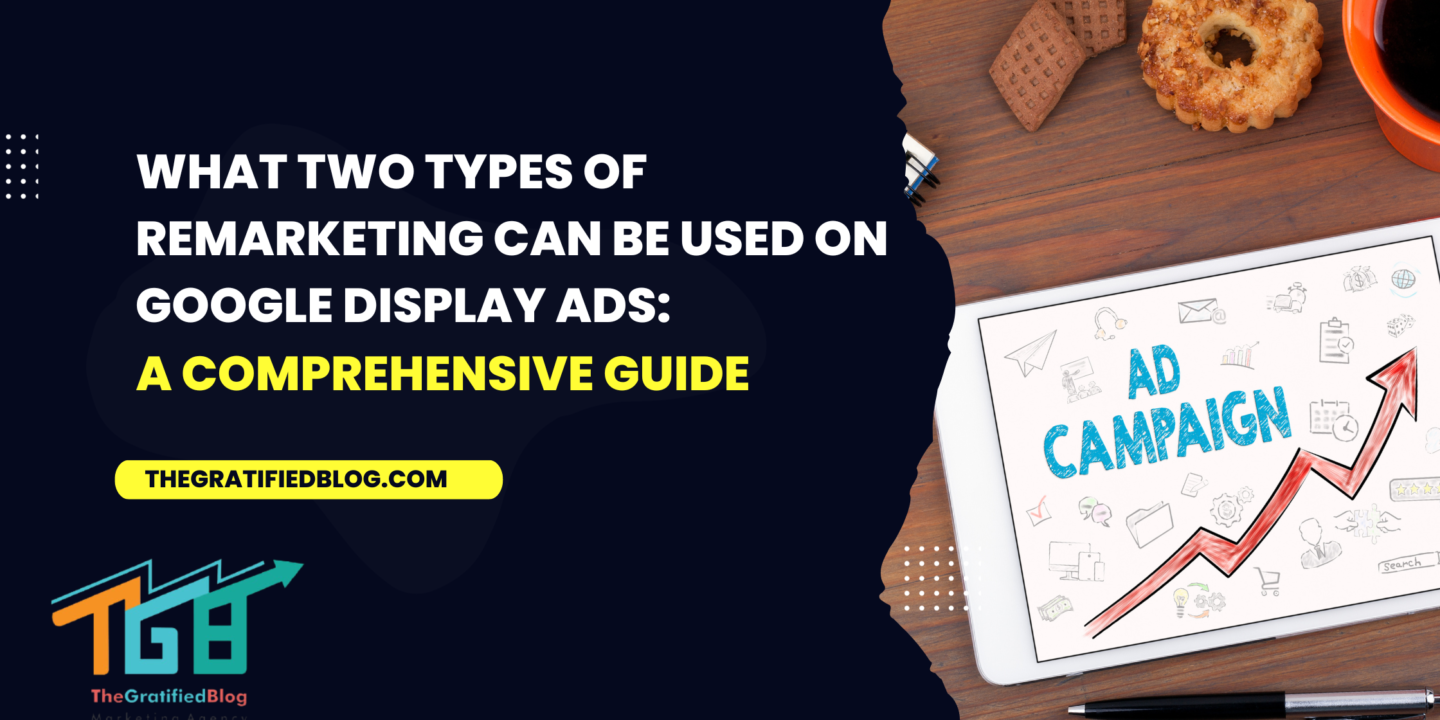
Have you ever wondered, “What Two Types of Remarketing Can Be Used on Google Display Ads?” You’re in the right place! Let’s dive into the world of Google Display Ads and its powerful remarketing capabilities.
If you’ve spent any time online, chances are you’ve come across Google Display Ads. These are the visuals you might see on your favorite news sites, blogs, or even when you’re catching up on YouTube videos. In the vast sea of online advertising, one strategy stands out: remarketing. But why is it so crucial?
What is Remarketing?
Ever found yourself browsing a product online and then seeing ads for that very product on various other websites over the next few days? It’s not coincidence—it’s remarketing in action! But let’s dive a bit deeper and see what this digital magic is all about.

Breaking Down Remarketing:
- Definition: Remarketing, often interchangeably used with retargeting, is an ingenious digital strategy. In simple terms, it lets businesses display targeted ads to users who’ve interacted with their website or app in the past.
- Purpose: Here’s a relatable scenario: You’re online shopping for a new backpack. You click on a few, but then get a call and close the website without buying anything. Later, you see ads for those same backpacks. That’s remarketing nudging you to finish what you started.
Connection with Google Display Ads:
When talking about remarketing, a burning question often emerges: “What Two Types of Remarketing Can Be Used on Google Display Ads?” Here’s a snapshot:
- Standard Remarketing: This is like a digital tap on the shoulder. Google serves your ads to past visitors as they navigate other websites, videos, and apps within its vast Display Network.
- Dynamic Remarketing: This is a bit more personalized. It’s like someone reminding you of the exact color and model of the backpack you were looking at. Dynamic remarketing tailors the ad based on specific products or services users viewed on your site.
The Power and Benefits of Remarketing:
- Efficiency: Imagine trying to convince someone to try a new ice cream flavor versus nudging them to have their favorite one. The latter is easier, right? That’s remarketing for you – targeting individuals already interested.
- Better ROI: Every business owner’s dream is to get the most out of their advertising bucks. Remarketing can make those dreams come true by targeting a ‘warm’ audience, leading to potentially higher conversion rates.
- Brand Stickiness: Every time users see an ad, even if they don’t click on it, it reinforces your brand in their mind. It’s like a catchy song – the more you hear it, the more it sticks.
What Two Types of Remarketing Can Be Used on Google Display Ads
When navigating the online realm, a burning question often emerges for marketers and the curious alike: “What Two Types of Remarketing Can Be Used on Google Display Ads?” Let’s peel back the layers and shed some light on this.

1. Standard Remarketing:
Picture this: You’re online, exploring a website about travel destinations. A day later, as you’re checking out a news site or watching a fun YouTube video, an ad pops up showcasing exotic holiday spots from the website you browsed earlier. That’s the charm of Standard Remarketing in action.
- Deep Dive into its Mechanism:
- This method targets users based on their past visits to your website.
- As these internet-goers explore other corners of the web, they’re presented with your ads, like subtle, friendly reminders.
- Shining Benefits:
- Consistent Brand Presence: Whether they’re researching a project or catching up on celebrity gossip, users will see your brand, ensuring it remains top-of-mind.
- Rekindling Interest: It’s like bumping into an old friend in different parts of town, reigniting past conversations and interests.
2. Dynamic Remarketing:
Here’s a relatable scenario: You’re shopping online, eyeing a trendy jacket but leaving without purchasing. Later, not only do you see ads for that jacket, but also for matching accessories. That’s Dynamic Remarketing, making your online experiences feel personalized.
- Understanding its Magic:
- Tailored ads are generated based on specific products or services users viewed on your website.
- Rather than showing a generic brand ad, users are treated to custom-tailored visuals aligning with their previous explorations.
- Standout Benefits:
- Customized Connection: Every ad feels handpicked for the user, creating a personalized shopping experience.
- Boosted Potential: By reconnecting users with their past interests, there’s a heightened chance they’ll make a purchase or engage further.
Reflecting once more on our pivotal query, “What Two Types of Remarketing Can Be Used on Google Display Ads?” – it’s evident that Google has equipped advertisers with robust tools. Both Standard and Dynamic Remarketing serve as bridges, linking potential customers back to products or services they’ve shown interest in. Imagine it as a tech-savvy salesperson, remembering your preferences and making sure you find what you’re looking for, every step of the way!
Key Benefits of Using Both Types of Remarketing
Remarketing is akin to a friendly shopkeeper reminding you of the lovely items you admired in their store, but didn’t buy. But what happens when this reminder comes in multiple forms, each catering to different stages of your buying journey? This brings us to the pivotal question: “What Two Types of Remarketing Can Be Used on Google Display Ads?” The answer offers multiple advantages for businesses, and here’s why using both types can be a game-changer.
- Enhanced Brand Recall:
The human mind thrives on repetition. The more you see something, the better you remember it.
- Repeated Exposure: Both standard and dynamic remarketing ensure your brand is frequently visible to potential customers.
- Familiarity Breeds Comfort: Over time, repeated exposure can create a sense of trust and comfort with your brand, even if the viewer hasn’t interacted directly with your business.
- Increased Conversion Opportunities:
Both types of remarketing serve to nudge users closer to that ‘Buy Now’ button.
- Re-Engaging Potential Customers: Standard remarketing serves as a gentle push, reminding users of their initial interest.
- Tailored Push: Dynamic remarketing is a more assertive nudge, showcasing products or services the user was specifically interested in, leading to higher chances of a conversion.
- Cost-Efficient Advertising:
Money spent on advertising should bring in more money. Remarketing is a fantastic tool in this regard.
- Targeted Approach: Instead of casting a wide net and hoping for the best, both remarketing methods ensure your ad dollars target individuals more likely to convert.
- Maximized ROI: By focusing on ‘warm leads’ (people who’ve already shown interest), you’re likely to get a better return on investment.
- Personalized User Experience:
In a world bustling with generic ads, a personal touch can make all the difference.
- Feels Custom Made: Dynamic remarketing, especially, makes users feel that the advertisement was crafted specifically for them, enhancing their overall experience.
When pondering “What Two Types of Remarketing Can Be Used on Google Display Ads?”, it’s essential to understand that both these strategies, when used together, amplify each other’s strengths. The combined approach ensures that potential customers not only remember your brand but are also consistently guided back, increasing the likelihood of them making a purchase or taking a desired action.

Tips for Effective Remarketing on Google Display Ads
The digital realm is vast, and capturing the attention of users can be akin to catching butterflies – fleeting and elusive. But here’s the magic trick: Remarketing! If you’re scratching your head, wondering “What Two Types of Remarketing Can Be Used on Google Display Ads?”, you’ve begun unraveling this intriguing tapestry. But, knowing is only half the battle. Implementing it effectively is where mastery is attained. Dive in for some golden tips!
- Segment Your Audience Thoughtfully:
Remember, one size doesn’t fit all, especially in the dynamic world of online advertising.
- Categorize with Care: Visitors come with varied intentions. Some window-shop, others are ready to buy, and a few might abandon their cart midway. Recognize these patterns and categorize them.
- Craft Tailored Ads: Someone revisiting might appreciate a gentle nudge about their abandoned cart, while a newcomer might resonate more with a broader brand message.
- Limit Ad Frequency for Refreshing Encounters:
You wouldn’t appreciate a friend repeating the same story, would you? Apply the same logic to your ads.
- Keep it Fresh: Continuous bombardment with the same ad can desensitize users or worse, irritate them.
- Harness Frequency Capping: Google Display Ads offer this fantastic feature. Decide a cap on how often a single user sees your ad, ensuring variety and freshness.
- Design Ads that Resonate:
In this vast sea of information, standing out is crucial.
- Eye-Catching Visuals: Craft ads with vibrant, compelling visuals ensuring they’re in harmony with your brand.
- Action-Prompting CTAs: Your Call to Action should be like a magnet, pulling users towards it. Whether it’s “Discover More” or “Grab the Deal”, make it irresistible.
- Ensure Dynamic Remarketing Truly is Dynamic:
Diving back into our initial question, “What Two Types of Remarketing Can Be Used on Google Display Ads?” – If dynamic remarketing is your choice, ensure your creatives match the dynamism.
- Stellar Product Images: Offer crystal-clear, appealing images of products the user previously glanced at.
- Keep Info Up-to-Date: Nothing sours an experience faster than outdated product details or mismatched prices. Stay current.
- Stay On Your Toes – Monitor and Adjust:
The digital landscape shifts continuously. Your strategies should dance along.
- Regular Insights Glean: Dive into metrics often, extracting insights about what’s resonating with users and what’s falling flat.
- Adaptive Strategies: Based on data, tweak your campaigns. Maybe the visuals need a refresh, or perhaps the target audience requires refinement.
Embarking on a journey with Google Display Ads is exciting. Remarketing amplifies this experience. But remember, while knowing about the “Two Types of Remarketing” is the stepping stone, the path to success is carved with continuous learning, adaptation, and a sprinkle of creativity.
Potential Pitfalls to Avoid in Remarketing
Remarketing on Google Display Ads is a powerful tool, but like any tool, it can have its challenges. To ensure success, it’s vital to navigate potential pitfalls and make the most of this strategy.
- Risks of Overexposing Audiences to Ads:
Imagine hearing the same joke repeatedly. It becomes less funny and more annoying over time. The same principle applies to overexposing audiences to your ads.
- Banner Blindness: When users see your ad too often, they may develop “banner blindness.” In other words, they start ignoring your ads because they’ve seen them too frequently.
- Annoyance: Overexposure can lead to user annoyance, which is the last thing you want to associate with your brand.
- Importance of Ensuring Ads are Relevant and Not Generic:
Relevance is the heart of any successful remarketing campaign. Irrelevant or generic ads can quickly alienate your audience.
- The Relevance Factor: Users are more likely to engage with ads that are tailored to their interests and needs.
- Avoiding Generic Content: Generic ads that don’t address the user’s previous interactions or preferences can feel like a wasted opportunity.

Conclusion
So, there you have it! The answer to “What Two Types of Remarketing Can Be Used on Google Display Ads?” Whether you’re a business owner looking to boost sales or just a curious individual, remarketing is a tool worth understanding and using.
Interested in diving deeper? Explore more about Google Display Ads and enhance your digital marketing game today!








No Comments